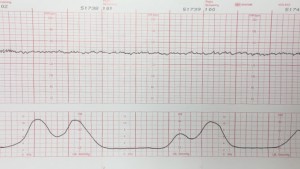During latent phase labor (prior to 4 cm), contractions may occur every 3-5 minutes and may or may not be painful.
A normal contraction pattern in active labor shows contractions occurring about every 2-3 minutes and lasting about 60 seconds.
If contractions are less often than every 2-3 minutes in the active phase, labor may progress more slowly, if at all.
While less frequent contractions are the rule in latent phase labor (prior to 4 cm), they are the exception in active labor.
Coupling
Coupling means that two contractions occur one right after the other rather than the normal pattern.

Usually, coupling is followed by a longer contraction-free interval. Tripling can also be seen where three contraction occur without any significant recovery time.
If labor is progressing normally, coupling can be ignored. Often, however, coupling is associated with dysfunctional progress in labor. In these cases, coupling can be treated with:
- Rest
- Hydration
- Narcotics
- Epidural Anesthesia
- Oxytocin
Tachysystole
If contractions are persistently more often than 5 contractions in 10 minutes, this is called “tachysystole.”

Tachysystole poses a problem for the fetus because it allows very little time for resupply of the fetus with oxygen and removal of waste products. For a normal fetus, tachysystole can usually be tolerated for a while, but if it goes on long enough, the fetus can be expected to become increasingly hypoxic and acidotic.
Tachysystole is most often caused by too much oxytocin stimulation. In these cases, the simplest solution is to reduce or stop the oxytocin to achieve a more normal and better tolerated labor pattern. Other causes of tachysystole include:
- Dehydration
- Placental abruption
- Pre-eclampsia
- Chorioamnionitis
In cases of spontaneous tachysystole, increasing maternal hydration and placement in the lateral decubitus position may slow the contractions.
